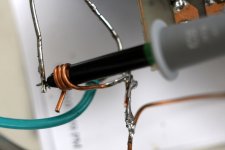I think those mosfets are genuine, but how can one be sure? Try to get the lc variant (low gate charge) if you're going to make the effort of getting other mosfets.
Indeed the J201 Idss will make a big difference in the output voltage.
Indeed the J201 Idss will make a big difference in the output voltage.
Are IRF640 compatible without losing quantifiable performance or creating oscillations? I have a second 5d board and no IRFBCs. I demand support! LOL.😀 



I'll have to get back to you about the irf640. But if you're patient I'll send you 5k boards and more irfbc40s to fry 😀
mmmmm... a new recipe: Mosfet τηγανητό (tiganitò=fried)! Must be good! 😀
Gonna try next time I go to Greece 😛
Gonna try next time I go to Greece 😛
But you can do it at home too, as you already know the recipe 🙂 Just push you shunts to the limit. You should see my parts cemetery 😀
So a few days ago I came across this fully working HP 3585A spectrum analyzer at a price I couldn't pass... and it arrived today. How is this related to the regulator? Well, I should be able to run some better measurements now.
The other day I reported that I felt the CCS negative heatsink was hotter than the positive and suspected the CCS current was not balanced between the positive and negative CCSs. I would say I need to repeatedly remind myself not trusting too much human senses and perceptions (would this make me a buddhist?) - I later measured the CCS currents, on the positive it was 139.5mA and the negative 140.9mA. Yes, it was hotter, but the difference was only very little. There is absolutely no concerns there.
When human minds focus on something, the result tends to be exaggerated hence not reliable. This leads me to fancy that we audiophiles who have "golden" ears may be chasing for 10% improvement on our sound system in objective reality, but we are training our senses to magnify that 10% difference to 500%, and that would probably be the real game.
When human minds focus on something, the result tends to be exaggerated hence not reliable. This leads me to fancy that we audiophiles who have "golden" ears may be chasing for 10% improvement on our sound system in objective reality, but we are training our senses to magnify that 10% difference to 500%, and that would probably be the real game.
So a few days ago I came across this fully working HP 3585A spectrum analyzer at a price I couldn't pass... and it arrived today. How is this related to the regulator? Well, I should be able to run some better measurements now.
Cool! Happy measuring.🙂
Yeah, 90lb monster, couldn't believe my eyes when it arrived.  The dynamic range isn't that great, only 80dB, but there are some tricks for improving it a bit. Still, if there's any oscillation between the 60MHz true rms Fluke and this 40MHz spectrum thingy... it'll get caught.
The dynamic range isn't that great, only 80dB, but there are some tricks for improving it a bit. Still, if there's any oscillation between the 60MHz true rms Fluke and this 40MHz spectrum thingy... it'll get caught.
In other news, I've replaced more opamps in my e-mu 0404 usb interface, which I was using previously for measuring. Not sure actually if it improved anything at all. Some guy from e-mu posted in a forum that the bottleneck is not the opamps. Being an insider, he might be onto something.
 The dynamic range isn't that great, only 80dB, but there are some tricks for improving it a bit. Still, if there's any oscillation between the 60MHz true rms Fluke and this 40MHz spectrum thingy... it'll get caught.
The dynamic range isn't that great, only 80dB, but there are some tricks for improving it a bit. Still, if there's any oscillation between the 60MHz true rms Fluke and this 40MHz spectrum thingy... it'll get caught.In other news, I've replaced more opamps in my e-mu 0404 usb interface, which I was using previously for measuring. Not sure actually if it improved anything at all. Some guy from e-mu posted in a forum that the bottleneck is not the opamps. Being an insider, he might be onto something.
The specs show 20Hz to 40Mhz, but when I turn it on you can choose the start frequency as 0.? hertz. Probably below 20Hz the measurements don't make any sense. 🙁
If it can really go near DC will be important for some indications in some parts and ccts. But 20Hz is not bad. How much did you pay? Is it fully working/calibrated?
Fully working, probably no longer calibrated, as most of them are in this state by the time they go on sale.
So a few days ago I came across this fully working HP 3585A spectrum analyzer at a price I couldn't pass... and it arrived today. How is this related to the regulator? Well, I should be able to run some better measurements now.
Congratulations for the new toy.
Last edited:
Thanks guys, hopefully I can post some results next week.
While on the subject of measuring, there's something I'd like to mention again. When measuring such low level signals, everything connected to the measuring point can introduce noise. This includes the scope or voltmeter probe. Attached is an image of how I connect the probe, with a GND wire as short as possible.
While on the subject of measuring, there's something I'd like to mention again. When measuring such low level signals, everything connected to the measuring point can introduce noise. This includes the scope or voltmeter probe. Attached is an image of how I connect the probe, with a GND wire as short as possible.
Attachments
- Status
- Not open for further replies.
- Home
- Amplifiers
- Power Supplies
- My take on a discrete shunt voltage regulator


